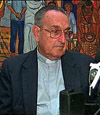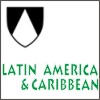|
|

|
||
| Home | Sisters | Associates | Friars | Laity | Nuns | Link to Groups | World OP | DLC | |||
2005
Meeting
Voices of the
Americas
CODALC
website
(Spanish)
CIDALC
website
(Spanish)
Latin American
Press website
United Nations
New York
Geneva
| International Seminar | |||
Constructing Peace from the Truth
Fr.Juan Gerardi was appointed bishop in the diocese of Vera Paz in 1967 and later on in the diocese of Quiché. Both dioceses were inhabited by an extremely poor indigenous population. Vera Paz traces its history back to the time of Bartolomé de las Casas. Fr Juan made it his priority to work with the indigenous and began courses of formation for catequists, formation of Delegates of the Word and also founded a Center of Social Formation. In September 1974, he was elected bishop of Quiché. In the face of continued violence, Bishop Gerardi defended his people and his pastoral agents. Returning from a visit to Rome in 1980, in which he shared with the Pope the reality of Guatemala, the military prevented his re-entry to the country for two years. In 1988, the Bishops’ Conference appointed him to a commission of Reconciliation. He created an Office of Human Rights and began an interdiocesan project called (REMHI- Recuperation of Historic Memory) which then became his “pastoral” – trying to learn the truth through testimonies of witnesses of the past. He was convinced that only through telling the truth would peace and reconciliation be possible. The presentation of the results of the REMHI Commission on April 24, 1998, in which the massive participation of the military in the massacres was made public, became the direct cause of his death two days later on April 26, 1998 as he returned to his house on a Sunday night. A group of 11 Central American Dominican Sisters, friars and laity participated in the tenth anniversary of Archbishop Gerardi’s death by attending an international seminar honoring his life and his death. We heard testimony from persons who were part of the truth commission, from those who helped gather the testimonies over the years and of those indigenous who suffered cruelly during those years. The different speakers distinguished between history that is “taught” and history “that is recovered”. In the case of “history recovered”, the disappeared have names and are no longer statistics, They spoke also of “collective amnesia” that strikes after an event so horrible that no one wants to remember it. “He who guards memory, guards life; he who does not guard memory is dead” The report of REMHI is in 4 volumes and speaker after speaker emphasized that the message of REMHI and of Juan Gerardi is one for the entire Church because it says “no” to impunity, conquers a sense of impotence in the face of horrible events and breaks the silence of what should never have been hidden.” Rigoberta Menchú, recipient of Nobel Peace Prize in 1992, gave a message of hope from her own experience of those years, as did Bishop Samuel Ruiz O.P. of Mexico. Besides the dead, there were 45,000 disappeared, more than a million refugees leaving for Mexico, Honduras etc. Many of the speakers pointed out that the possibility of being victims in Guatemala is not over. Rather, Guatemala is called to conciliate, to announce an alternative (and not just denounce the past), to create a Guatemala that is distinct, a Church in favor of the poor. One speaker asked us, “What would Gerardi say today in the face of the social situation of society, the continued murders and violence, organized crime, violation of Human Rights? Reconciliation arises from truth and justice.” “While the truth is not known, the wounds keep putrefying”. There was much emphasis on the role of the laity as subjects of the “new history” of a Guatemala that is distinct. “With recuperation of memory, one can be a “subject” for the first time in Guatemala, can raise one’s voice, work one’s memory, identify the emotions and interpret events and place names for all. It is memory that engenders the future”. As another presenter expressed it, “Mass without memory is not the Last Supper”. “Hope is a fragile thing and one has to organize it”. The seminar was proof of that! On Saturday, the actual anniversary day of the death of Archbishop Gerardi, we joined huge crowds in the Cathedral for the mass celebrated by Cardinal Quezada and marched with thousands from the cathedral to the house where Gerardi was killed. The intellectual authors of the murder have yet to be named and the Cardinal (in the presence of the vice-president of the country) said that the Church will continue to support the Office of Human Rights and continue to pursue those responsible. “Hope and Solidarity are twins”. Doris Regan, OP |
COMMEMORATING TENTH ANNIVERSARY OF MARTYRDOM OF ARCHBISHOP JUAN GERARDI  Bishop Juan Gerardi |
 Home | Contact Us | DLC Dominican Life | USA is sponsored by the Dominican Leadership Conference, the networking organization for elected leaders in the USA. Dominican Life | USA © 2002-2007, All Rights Reserved Web Editor: Anne Lythgoe, OP |
|---|

